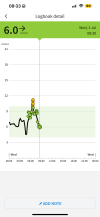Main thing here is - "don't panic"
For the obvious reason, but also because stress hormones are no help either...
I personally think that the first applied sensor is best thought of as a trial run - use it to learn a little about what the sensor does. After a few months, you will also be much more familiar with the fact that no two sensors are exactly the same..
beyond that, the key benefit of GCM is that it will give you information about what your body is doing, not generalised advice, or anyone else's opinion of what you should be seeing based on their experience..
There are generalisations that can usefully be made, but the definite benefit is that you will see what your own body is doing, and will start to make sense of it based on where you are on your own journey.
As for the Dawn Phenomenon... it's pretty complicated when you get right down to the details, but if you understand that there are lots of things going on to prepare you for the day, and in the same way that Diabetes (T2) is one of the end points of Insulin Resistance, you may find that your reaction to the various hormones that set you up for the day, change as you become more sensitive to them.
For me ... it took months for my "morning spike" to settle down, but each of us is different, it usually is not something that needs to be 'stopped' with any medication. In many ways - you should see something of a raise of blood glucose in the morning, but lots of things come in to play; levels of stress, sleep quality and regularity etc..
Definitely do not worry about the result of the first day...


